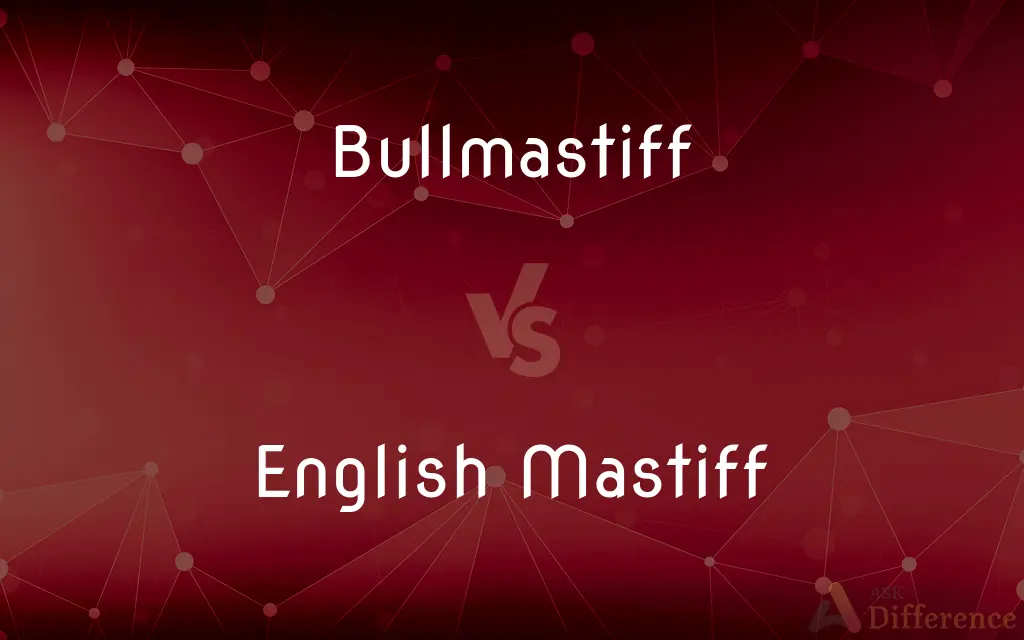Bullmastiff vs. English Mastiff — What's the Difference?
By Tayyaba Rehman & Maham Liaqat — Published on September 28, 2024
Bullmastiffs are powerful, yet agile guard dogs with a loyal demeanor, whereas English Mastiffs are known for their massive size and gentle, affectionate nature.

Difference Between Bullmastiff and English Mastiff
Table of Contents
ADVERTISEMENT
Key Differences
Bullmastiffs and English Mastiffs, both breeds admired for their impressive size and demeanor, differ significantly in their origins, size, and temperament.
The Bullmastiff, a cross between the Old English Bulldog and the English Mastiff, was bred in the 19th century to guard estates from poachers. They are large, robust dogs, but smaller and more agile than English Mastiffs, weighing up to 130 pounds. Bullmastiffs are known for their bravery, loyalty, and a protective instinct that makes them excellent guard dogs.
English Mastiffs, on the other hand, are one of the largest dog breeds, with a history that dates back to ancient times. They can weigh upwards of 200 pounds, with a calm and affectionate nature. Despite their intimidating size, English Mastiffs are gentle giants, known for their patience and docility, especially around children. They serve more as gentle companions and family pets rather than guard dogs, though their sheer size can be a deterrent to intruders.
In terms of appearance, Bullmastiffs have a more defined musculature, a shorter muzzle, and a more alert expression, reflecting their breeding for guard work. English Mastiffs have a larger head, a longer muzzle, and a more laid-back demeanor. Both breeds require moderate exercise, but Bullmastiffs may have slightly higher energy levels due to their working heritage.
Healthwise, both breeds share some common issues like hip dysplasia and gastric torsion but due to their larger size, English Mastiffs may have a shorter lifespan and more joint-related issues. Both breeds make loyal family members, but their considerable size and strength mean they need a handler who can provide firm, consistent training and socialization from a young age.
ADVERTISEMENT
Comparison Chart
Origin
Crossbreed (Old English Bulldog & English Mastiff)
Ancient breed
Size
Large, up to 130 lbs
Giant, often over 200 lbs
Temperament
Protective, loyal, agile
Gentle, affectionate, calm
Use
Guarding
Companion, family pet
Appearance
Defined musculature, shorter muzzle
Larger head, longer muzzle
Exercise Needs
Moderate, requires daily exercise
Moderate, but less due to size
Health Concerns
Hip dysplasia, gastric torsion
Hip dysplasia, joint issues, shorter lifespan
Lifespan
8-10 years
6-10 years
Ideal for
Families needing a guard dog
Families looking for a gentle companion
Compare with Definitions
Bullmastiff
Requires firm training from an early age.
Training sessions helped the Bullmastiff learn to obey commands quickly.
English Mastiff
One of the largest dog breeds, known for its gentle nature.
The English Mastiff lay quietly beside its owner, showcasing its calm demeanor.
Bullmastiff
Agile for its size, making it an effective protector.
Despite its bulk, the Bullmastiff moved swiftly to intercept an intruder.
English Mastiff
Requires space to accommodate its size.
The family moved to a home with a larger yard to give their English Mastiff more room.
Bullmastiff
A muscular guard dog known for its loyalty.
The Bullmastiff quietly watched over the family's large estate.
English Mastiff
Known for being exceptionally patient and good with children.
The English Mastiff patiently let the children climb over him.
Bullmastiff
Smaller and more alert than the English Mastiff.
The Bullmastiff's alert expression made it an intimidating presence.
English Mastiff
Serves as a deterrent simply because of its size.
Potential intruders were often scared off by the mere sight of the massive English Mastiff.
Bullmastiff
Protective but affectionate with its family.
The Bullmastiff was always gentle with the children, showing its softer side.
English Mastiff
Can be prone to laziness and needs encouragement to exercise.
The English Mastiff needed some coaxing to go on its daily walks.
Bullmastiff
A large, heavy-set, powerful dog of a breed developed from the bulldog and the mastiff.
Bullmastiff
Alternative case form of Bullmastiff
Common Curiosities
Which breed requires more grooming?
Both have short coats that require minimal grooming, but English Mastiffs may drool more, necessitating more frequent cleanups.
Are Bullmastiffs or English Mastiffs more suitable for families with children?
Both breeds are known to be good with children, but English Mastiffs are particularly noted for their gentleness and patience.
Are Bullmastiffs more aggressive than English Mastiffs?
Bullmastiffs are not necessarily more aggressive but are bred to be guard dogs and may have a more protective nature.
Why are English Mastiffs so expensive?
Their size means higher costs for breeding, healthcare, and feeding, which can contribute to a higher price for puppies.
Can these breeds live comfortably in hot climates?
Both breeds can struggle in extreme heat due to their size and should have access to cool, shaded areas and plenty of water.
Which breed is better for a small living space?
Neither breed is ideal for very small spaces, but Bullmastiffs may adapt better due to their slightly smaller size and lower exercise requirements.
How do I decide between a Bullmastiff and an English Mastiff?
Consider your living space, lifestyle, and what you're looking for in a dog. If you need a guard dog, a Bullmastiff might be better. If you prefer a gentle companion, an English Mastiff could be more suitable.
What's the biggest challenge in owning an English Mastiff?
Their massive size presents challenges in terms of space, food costs, and healthcare.
Is it difficult to train a Bullmastiff?
Bullmastiffs are intelligent and can be trained effectively with consistency and positive reinforcement, though they can also be stubborn.
Which breed has a longer lifespan?
Bullmastiffs have a slightly longer lifespan on average, though both breeds have relatively short lifespans due to their size.
Share Your Discovery

Previous Comparison
Blind Spot vs. Yellow Spot
Next Comparison
Broker vs. LenderAuthor Spotlight
Written by
Tayyaba RehmanTayyaba Rehman is a distinguished writer, currently serving as a primary contributor to askdifference.com. As a researcher in semantics and etymology, Tayyaba's passion for the complexity of languages and their distinctions has found a perfect home on the platform. Tayyaba delves into the intricacies of language, distinguishing between commonly confused words and phrases, thereby providing clarity for readers worldwide.
Co-written by
Maham Liaqat











































